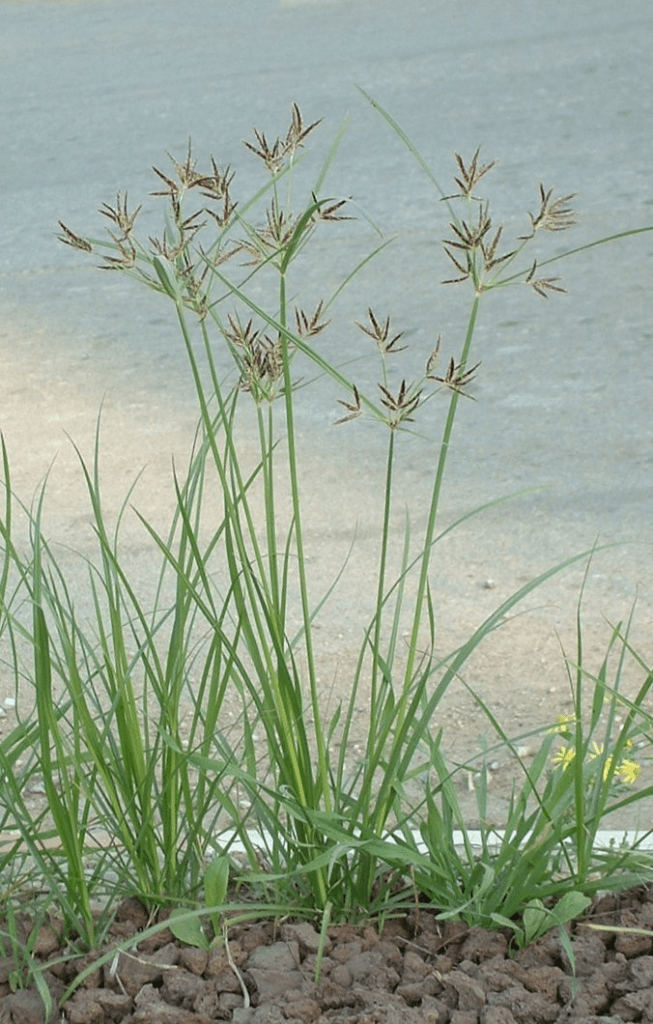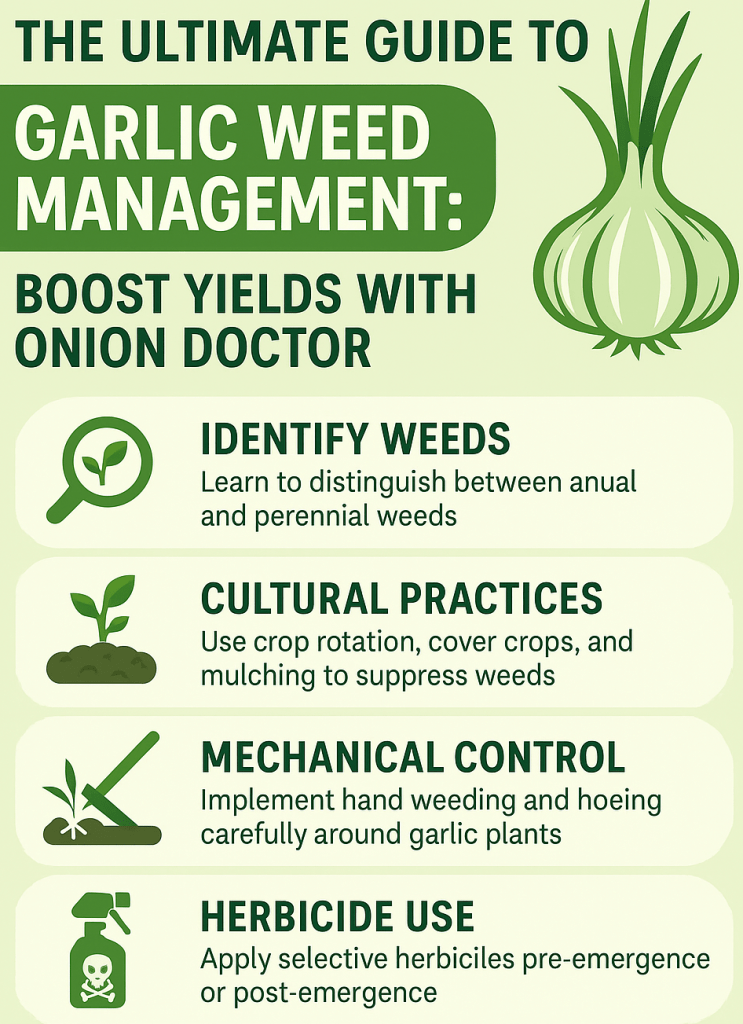Garlic farming is a rewarding venture, but weeds can be a silent yield-killer if not managed effectively. At Onion Doctor, we understand the challenges Kenyan farmers and garlic enthusiasts worldwide face in keeping their crops thriving. In this comprehensive guide, we’ll dive into the fascinating world of garlic weeds, their impact, and proven management strategies to ensure your garlic beds flourish. Packed with practical tips, scientific insights, and a touch of humor, this blog is your go-to resource for mastering weed control in garlic farming. Let’s make your garlic harvest the envy of every farmer in Nyeri, Kiambu, and beyond!

WHY WEED MANAGEMENT MATTERS IN GARLIC:
Garlic, with its shallow roots and narrow leaves, is a delicate crop that struggles to compete with aggressive weeds. Weeds steal sunlight, water, nutrients, and space, reducing bulb size and yield by up to 50% if left unchecked. In Kenya, where garlic farming is booming, weeds like nut grass, couch grass, black jack, and pigweed are notorious for wreaking havoc. Effective weed management isn’t just about aesthetics—it’s about protecting your investment, maximizing yields, and ensuring high-quality, marketable garlic.
IMPACT OF WEEDS ON GARLIC:
- Competition for Resources: Weeds outcompete garlic for essential growth factors, stunting development and reducing bulb size.
- Pest and Disease Havens: Weeds like black jack can harbor pests like onion maggots or diseases that harm garlic.
- Harvest Challenges: Late-season weeds tangle with garlic, making harvesting tedious and reducing bulb quality.
- Allelopathy: Some weeds, like couch grass, release chemicals that inhibit garlic root growth, stressing young plants.
By tackling weeds early and consistently, you protect your garlic’s potential and ensure a bountiful harvest.
COMMON WEEDS IN GARLIC FARMING AND THEIR CHARACTERISTICS:
Understanding your enemy is the first step to victory. Here’s a rundown of the most troublesome weeds in garlic farming, especially in regions like Kenya, along with their traits and why they’re a problem.
1.NUT GRASS:
- Type: Perennial, invasive
- Traits: Spreads rapidly via underground tubers that survive for years. Difficult to eradicate once established.
- Impact: Competes aggressively for water and nutrients, reducing garlic bulb size. Tubers can regenerate even after cultivation.
- Where It Thrives: Moist, poorly drained soils common in Kenyan highlands.

2.COUCH GRASS:
- Type: Perennial
- Traits: Spreads via rhizomes, regenerating from small fragments. May release allelopathic chemicals that harm garlic roots.
- Impact: Reduces yield by outcompeting garlic for light, water, and nutrients.
- Where It Thrives: Fertile soils with high organic matter

3. BLACK JACK:
- Type: Annual
- Traits: Fast-growing with sticky seeds that spread rapidly. May suppress garlic through allelopathy.
- Impact: Competes for nutrients and light, reducing garlic vigor and yield.
- Where It Thrives: Disturbed soils, common in Kenyan farmlan

4.PIG WEED:
- Type: Annual
- Traits: Produces thousands of seeds, spreading quickly if not controlled early.
- Impact: Outcompetes garlic for resources, leading to smaller bulbs and lower yields.
- Where It Thrives: Warm, sunny conditions, prevalent in semi-arid plains.

WEED MANAGEMENT STRATEGIES:
Effective weed control in garlic farming requires an integrated approach combining cultural, mechanical, chemical, and organic methods. Here’s how to keep your garlic beds weed-free with Onion Doctor’s expert advice.
1.PRE-PLANTING PREPARATION: START CLEAN:
Weeds are easier to prevent than to cure. Preparing your field before planting garlic sets the stage for success.
- Stale Seedbed Technique: Till the soil, allow weeds to germinate, and eliminate them with shallow cultivation or herbicides before planting. This reduces the weed seed bank.
- Soil Solarization: Cover moist soil with clear plastic for 4–6 weeks during hot months to kill weed seeds and pathogens. Ideal for Kenyan semi-arid regions.
- Choose Weed-Free Fields: Avoid fields with heavy infestations of perennial weeds like nutsedge or field bindweed. Scout and keep records of weed species to select the best fields.
- Crop Rotation: Rotate garlic with non-host crops like maize, sorghum, or mustard, which release bio-fumigants that suppress weeds and pests.
2.CULTURAL PRACTICES: GIVE GARLIC THE UPPER HAND:
Cultural practices enhance garlic’s ability to compete with weeds while minimizing weed growth.
- Optimal Planting Density: Plant garlic at recommended spacing to maximize yield without overcrowding, which limits mechanical weeding options.
- Mulching: Apply a thick layer of straw, paper, or organic mulch (3–4 inches) before weeds emerge to suppress growth and keep soil cool. Mulching also reduces nematode pressure, a bonus for Kenyan farmers.
- Timely Planting: Plant garlic in October/November in Kenya to give it a head start before spring weed flushes.
- Drip Irrigation: Use drip irrigation to deliver water directly to garlic roots, reducing moisture available to weeds.

3. MECHANICAL CONTROL: HANDS-ON WEEDING:
Mechanical methods are labor-intensive but effective, especially for smallholder farmers.
- Hand Weeding: Meticulously remove weeds early in the season when they’re small and easier to control. This is critical for organic systems where herbicide options are limited.
- Hoeing: Lightly hoe between rows every 2–3 weeks to disrupt young weeds. Avoid deep cultivation near garlic to prevent root damage.
- Timing is Key: Weed before garlic begins bulbing, as cultivation during bulbing can prune shallow roots and reduce yields.
4. CHEMICAL CONTROL: TARGETED HERBICIDE USE:
Herbicides are a fast, cost-effective way to manage weeds, but they must be used carefully to avoid crop injury.
- Pre-Emergence Herbicides:
- Pendimethalin: Suppresses annual grasses, broadleaf weeds, and dodder. Apply 2–14 days after transplanting at 50ml per 20L of water.
- Napropamide: Effective against littleseed canarygrass and other annual grasses.
- Post-Emergence Herbicides:
- WEMBE 200 SL: A non-selective herbicide for clearing weeds during land preparation. Ideal for tough weeds like nut grass.
- Precautions:
- Avoid applying herbicides to young garlic without adequate cuticle development.
- Tank-mix cautiously, as combinations like GoalTender with bromoxynil can harm small garlic plants.
- Rotate herbicide modes of action to prevent resistance, especially in weeds like littleseed canarygrass.
5.ORGANIC WEED MANAGEMENT: SUSTAINABLE SOLUTIONS:
For organic garlic farmers, weed control relies on a combination of non-chemical methods.
- Organic Herbicides: Use contact herbicides like clove oil or vinegar-based products on weed green tissue, avoiding garlic seedlings. These have limited residual activity, so combine with mulching and hoeing.
- Cover Crops: Grow cover crops like mustard or sorghum-Sudan grass in the fall before planting garlic to suppress weeds and improve soil health.
- Frequent Cultivation: Regularly hand-weed or cultivate to prevent annual bluegrass and other prolific weeds from setting seed.
6.MONITORING AND RECORD-KEEPING:
Keep tabs on weed populations to stay ahead of infestations.
- Scout Fields: Monitor fields before and during the growing season to identify dominant weed species. Focus on hard-to-control weeds like yellow sweetclover or nutsedge.
- Maintain Records: Document weed species, herbicide applications, and control outcomes to inform future planting decisions.
ONION DOCTOR`S SPRAY AND FEEDING PROGRAM:
At Onion Doctor, we offer a tailored spray and feeding program to optimize garlic yields while keeping weeds at bay. For just KES 5,000 ($38.66), our agronomists provide a customized plan, including:
- Herbicide Recommendations: Guidance on safe, effective herbicide use.
- Fertilizer Schedules: Balanced feeding to boost garlic vigor and outcompete weeds.
- Pest and Disease Management: Integrated solutions to tackle onion maggots, nematodes, and more.
Contact us via WhatsApp at +254703982228 or email info@oniondoctor.co.ke to get started. Follow us on TikTok, Instagram, Facebook, YouTube, and X for daily tips on garlic farming.

CONCLUSION:
Weeds don’t have to be the villains in your garlic farming story. With the right strategies—pre-planting preparation, cultural practices, mechanical and chemical controls, and organic methods—you can keep your garlic beds thriving. At Onion Doctor, we’re here to support you with quality seedlings, expert training, and affordable agronomic services. Let’s make your garlic harvest a success, whether you’re farming in Kenya’s highlands or beyond!
Contact us for: Onion seedlings, Garlic seedlings, Germinated garlic cloves, Farm planning services, Soil testing, training on onion and garlic growing, Drip irrigation installation and maintenance, Agronomic support, Onion and Garlic value pack and Farm management. For free consultation, placing orders or booking a visit with an agronomist, please contact us via Call or what’s app +254703982228, Email: Info@oniondoctor.co.ke. You can also check out our social media handles for daily updates on TikTok: https://www.tiktok.com/@oniondoctorke?_t=ZM-8wmsTu0qumO&_r=1 Instagram: https://www.instagram.com/oniondoctorke?igsh=MTVoaHF3aWUydTJzaQ==Facebook:https://www.facebook.com/share/16SwgYn2dG/ Youtube:https://youtube.com/@oniondoctorke?si=u5Jnd-r0qU9UDYqL and Twitter: https://x.com/OnionDoctorKe?t=FR3JXlS_oN1vjjUgAtfyzg&s=09.